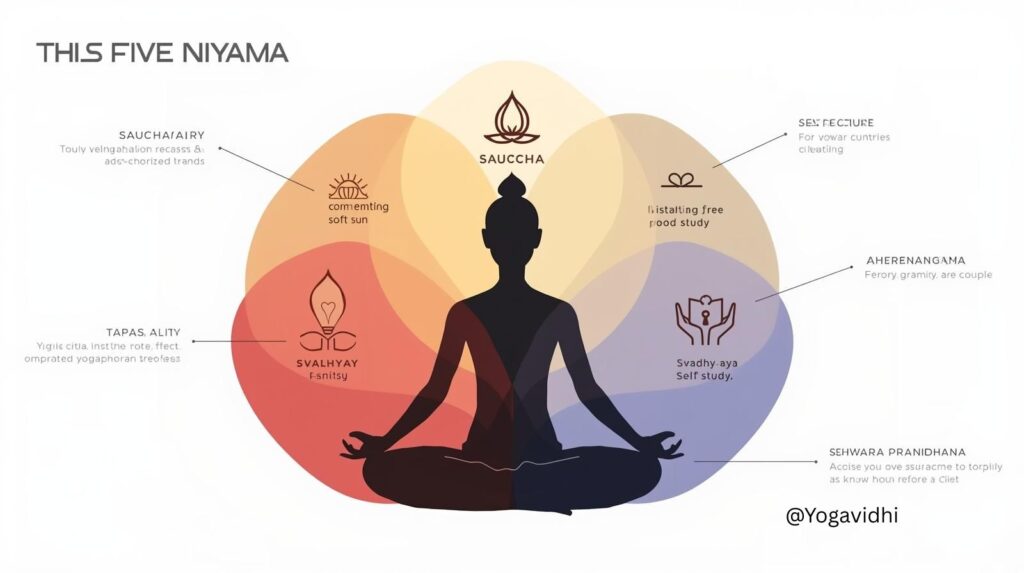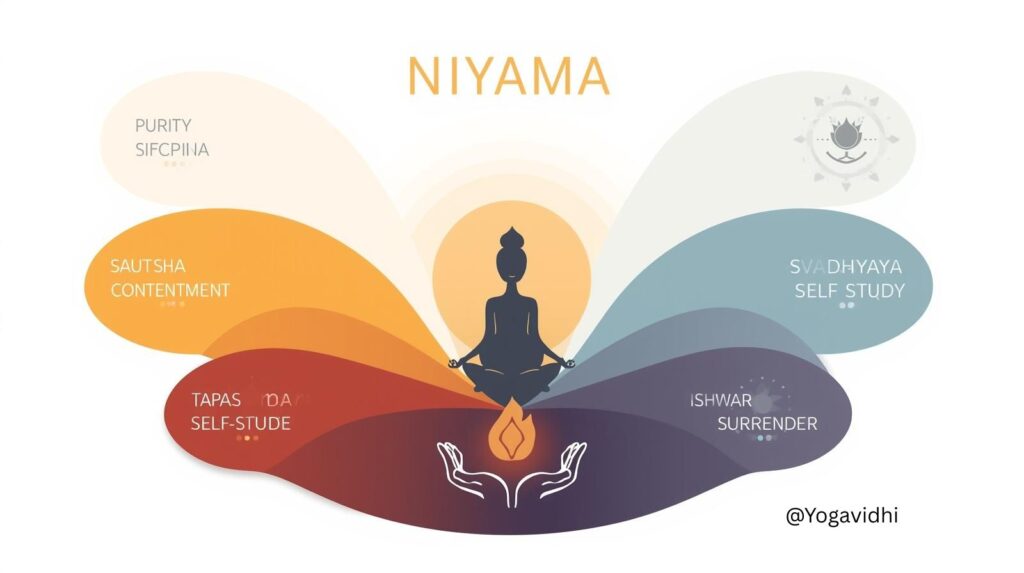Yoga is far more than a series of postures or breathing exercises. At its heart, it is a way of life—a philosophy that teaches us how to live in harmony with ourselves and the world around us. While most people are familiar with the physical aspect of yoga, known as asanas, true yoga extends beyond the mat. According to the sage Patanjali’s Yoga Sutras, the foundation of yoga lies in eight limbs (Ashtanga Yoga), which guide a practitioner toward physical, mental, and spiritual enlightenment.
The first two limbs, Yamas and Niyamas, form the ethical and moral framework of yoga. While Yamas focus on social ethics—how we interact with others—Niyamas in yoga refer to the personal observances or disciplines that shape our inner world. These practices cultivate purity, self-awareness, and contentment, preparing the mind for deeper states of meditation and self-realization.
In this article, we’ll explore the meaning of Niyamas in yoga, their five guiding principles, and how you can integrate them into your modern lifestyle for inner peace, balance, and spiritual growth.
Niyamas are the positive observances or personal disciplines in yoga philosophy that cultivate inner growth and spiritual awakening. As the second limb of Patanjali’s eightfold path, the five niyamas—Shaucha (purity), Santosha (contentment), Tapas (self-discipline), Svadhyaya (self-study), and Ishvarapranidhana (surrender to a higher power)—serve as guiding principles for one’s relationship with oneself.
Table of Contents
Understanding the Concept of Niyamas in Yoga
In Sanskrit, the word Niyama means “observance” or “positive duty.” It represents the ethical codes that govern one’s relationship with oneself. The Niyamas in yoga are about self-regulation, personal discipline, and cultivating positive habits that purify both body and mind.
Where Yamas teach us how to behave toward others, Niyamas teach us how to nurture our own inner being. Together, they form the foundation of yogic ethics. Practicing these principles helps eliminate mental clutter, cultivate spiritual awareness, and harmonize daily living with higher consciousness.
The five Niyamas, as described by Patanjali, are:
- Saucha (Purity)
- Santosha (Contentment)
- Tapas (Discipline)
- Svadhyaya (Self-Study)
- Ishvara Pranidhana (Surrender to the Divine)
Let’s dive deeper into each of these Niyamas and understand their relevance in today’s fast-paced world.
1. Saucha (Purity or Cleanliness)
Saucha comes from the Sanskrit root “shuch,” meaning purity or cleanliness. It refers not only to physical cleanliness but also to purity of mind, body, and surroundings.
In ancient yogic philosophy, Saucha was considered the first step toward spiritual evolution. A clean body leads to a clear mind, and a clear mind becomes receptive to higher wisdom.
Practicing Saucha in Daily Life
- Physical Purity: Maintaining hygiene, eating clean and balanced food, and practicing asana and pranayama to cleanse the body of toxins.
- Mental Purity: Avoiding negative thoughts, gossip, and emotional clutter. Regular meditation and mindful breathing purify the mind.
- Environmental Purity: Keeping your surroundings tidy and organized promotes inner clarity.
In today’s world, Saucha can also mean decluttering your digital space, choosing wholesome media consumption, and fostering healthy relationships.
2. Santosha (Contentment)
Santosha means contentment, acceptance, and gratitude. It teaches us to find happiness in the present moment, rather than constantly seeking more. In a world that glorifies ambition and comparison, Santosha reminds us to embrace simplicity and inner satisfaction.
When you practice Santosha, you begin to let go of what you lack and appreciate what you have. This mindset not only reduces stress but also nurtures emotional balance and joy.
Ways to Cultivate Santosha
- Start your day with gratitude journaling or silent appreciation.
- Detach from the need for external validation.
- Practice mindfulness to stay grounded in the present.
- Accept life’s imperfections with grace and faith.
Contentment doesn’t mean complacency—it means striving for growth while staying peaceful with where you are now.
3. Tapas (Discipline or Austerity)
Tapas originates from the Sanskrit root “tap,” meaning “to heat” or “to burn.” It represents self-discipline, inner fire, and the willingness to endure discomfort to achieve transformation.
In yoga, Tapas symbolizes the burning of impurities—laziness, doubt, and fear—through consistent practice and effort. It’s the discipline that pushes us to roll out the mat on tough days, maintain healthy habits, and persevere in the face of challenges.
How to Practice Tapas
- Commit to a daily yoga or meditation routine.
- Set realistic goals and follow through with consistency.
- Challenge yourself with practices that test patience and resilience.
- Observe moderation in eating, speaking, and behavior.
Tapas builds willpower, courage, and focus. It is the fuel that drives spiritual and personal growth, helping us evolve from within.
Read More: Yamas in Yoga: The Ethical Foundation of Yogic Living
Read More: Yoga for Men: Build Strength, Flexibility & Mental Clarity
4. Svadhyaya (Self-Study or Self-Reflection)
Svadhyaya combines two Sanskrit words—sva (self) and adhyaya (study). It means studying oneself to gain insight into one’s thoughts, actions, and motives. It also involves studying sacred texts and teachings that inspire spiritual awareness.
Svadhyaya encourages us to ask meaningful questions:
- Who am I beyond my thoughts and emotions?
- What patterns hold me back?
- How can I align my actions with my higher self?
Modern Ways to Practice Svadhyaya
- Keep a journal to reflect on thoughts and emotions.
- Read spiritual or philosophical books like The Bhagavad Gita or Yoga Sutras of Patanjali.
- Practice mindfulness to observe your mental habits.
- Engage in self-inquiry meditation or guided introspection.
Through Svadhyaya, we realize that our true nature is pure consciousness—beyond ego, roles, and achievements.
5. Ishvara Pranidhana (Surrender to the Divine)
Ishvara Pranidhana is the final and most profound of the five Niyamas in yoga. It means surrendering the ego and dedicating all actions to a higher power or divine consciousness.
In this context, Ishvara represents the divine within or the universal intelligence that governs all existence. Surrendering doesn’t imply weakness—it’s an act of faith, humility, and trust in life’s flow.
How to Embody Ishvara Pranidhana
- Begin your yoga or meditation practice with a prayer or intention.
- Release the need to control outcomes; focus on sincere effort.
- See challenges as opportunities for spiritual growth.
- Develop a sense of devotion—whether to God, nature, or your higher self.
When you practice surrender, your actions become more effortless, joyful, and aligned with universal harmony. You learn to accept what life brings without resistance, cultivating serenity and spiritual maturity.
How to Incorporate Niyamas into Daily Life
Bringing Niyamas in yoga into your daily routine is about consistency and mindfulness. You don’t have to master all five at once—start with one that resonates with you and gradually build upon it.
Here are some simple, actionable ways:
- Morning: Begin with gratitude (Santosha) and clean surroundings (Saucha).
- Midday: Stay disciplined with your work or practice (Tapas).
- Evening: Reflect on your actions and thoughts (Svadhyaya).
- Night: Offer your day’s efforts to the divine (Ishvara Pranidhana).
These small steps transform ordinary activities into spiritual practice. Over time, they refine your character, purify your mind, and strengthen your connection to your higher purpose.
Niyamas and the Path to Self-Realization
The Niyamas in yoga prepare the practitioner for deeper spiritual practices like meditation (Dhyana) and absorption (Samadhi). They act as inner tools that purify the mind, enabling clarity and focus.
By observing these five principles, you gradually dissolve ego-driven tendencies and awaken a sense of unity with all life. This is the essence of yoga—union of the individual soul (Atman) with the universal consciousness (Paramatman).
Each Niyama works as a stepping stone toward self-realization, guiding you from outer awareness to inner stillness.
Niyamas vs. Yamas: The Inner and Outer Ethics
While Yamas and Niyamas are often taught together, they serve different yet complementary purposes:
| Aspect | Yamas | Niyamas |
| Focus | Social ethics | Personal ethics |
| Direction | Outward (toward others) | Inward (toward self) |
| Purpose | Harmonious relationships | Inner discipline and purity |
| Examples | Ahimsa, Satya, Asteya | Saucha, Santosha, Tapas |
When both Yamas and Niyamas are practiced together, they create a balanced foundation for holistic living—one that harmonizes both external and internal worlds.
Modern Relevance of Niyamas in Yoga
In our modern world of stress, social media comparison, and constant distraction, the Niyamas in yoga are more relevant than ever. They provide timeless wisdom to cultivate balance, awareness, and peace amidst chaos.
- Saucha reminds us to detox our digital and physical environments.
- Santosha helps us practice gratitude in a world of consumerism.
- Tapas motivates us to maintain wellness routines and discipline.
- Svadhyaya encourages mindful self-reflection in a noisy world.
- Ishvara Pranidhana teaches us surrender and trust amid uncertainty.
By living through these principles, we embody the spirit of yoga—not just as exercise, but as a conscious lifestyle.

Conclusion
The Niyamas in yoga are not mere philosophical ideas—they are living practices that refine the mind, uplift the spirit, and bring lasting peace. When we practice cleanliness (Saucha), contentment (Santosha), discipline (Tapas), self-reflection (Svadhyaya), and surrender (Ishvara Pranidhana), we align our inner and outer worlds with harmony.
Incorporating these observances into daily life transforms every moment into a sacred act. You become more mindful, compassionate, and grounded—qualities that define true yoga.
So, start small. Choose one Niyama that speaks to your heart, and let it guide your journey toward self-realization. Over time, you’ll discover that the practice of Niyamas is not about perfection—it’s about transformation, awareness, and inner freedom.
FAQ:
Q. What are the Niyamas in Yoga?
Ans: The Niyamas in yoga are the five personal observances or disciplines outlined in Patanjali’s Yoga Sutras. They serve as inner guidelines for self-purification, personal growth, and spiritual awakening. The five Niyamas are Saucha (Purity), Santosha (Contentment), Tapas (Discipline), Svadhyaya (Self-study), and Ishvara Pranidhana (Surrender to the Divine). Practicing them cultivates mindfulness, harmony, and balance in everyday life.
Q. What is the difference between Yamas and Niyamas in Yoga?
Ans: While both are ethical foundations of yoga, they focus on different aspects of life.
Yamas are social restraints—guidelines on how we interact with others, such as truthfulness and non-violence.
Niyamas, on the other hand, are personal observances that focus inward, guiding us to purify, discipline, and reflect upon ourselves.
Together, they form the moral and spiritual base of yoga practice.
Q. Why are Niyamas important in yoga practice?
Ans: The Niyamas in yoga help practitioners build a strong internal foundation. They promote mental clarity, emotional balance, and spiritual awareness. By observing the Niyamas, one learns to lead a more mindful and ethical life—cultivating purity, gratitude, discipline, self-reflection, and surrender. These inner qualities prepare the mind for deeper practices like meditation and self-realization.
Q. How can beginners practice the Niyamas in daily life?
Ans: You can start incorporating Niyamas in yoga through small, mindful actions:
1. Saucha: Keep your surroundings clean and eat wholesome food.
2. Santosha: Practice gratitude and avoid comparisons.
3. Tapas: Stay consistent with your yoga or meditation routine.
4. Svadhyaya: Reflect through journaling or reading spiritual texts.
5. Ishvara Pranidhana: Surrender your efforts to a higher purpose.
These simple steps gradually lead to deeper inner peace and personal growth.
Q. Are the Niyamas still relevant in modern life?
Ans: Absolutely. The Niyamas in yoga offer timeless wisdom that helps us navigate the stress, distractions, and materialism of modern life. They remind us to live with intention, integrity, and awareness. Practicing these principles fosters balance between body, mind, and spirit—bringing a sense of calm, clarity, and connection even amidst life’s challenges.
Q. What are the five niyamas?
Ans: The five Niyamas, outlined in the Yoga Sutras, are ethical principles centered on personal discipline and inner growth rather than social behavior. They include Saucha (purity or cleanliness), Santosha (contentment), Tapas (self-discipline or purification through effort), Svadhyaya (self-study or reflection), and Ishvarapranidhana (devotion or surrender to a higher power).
Q. What was the first niyama?
Ans: The first niyama, Saucha, focuses on maintaining purity in the body, mind, and surroundings, promoting cleanliness and clarity in every aspect of life. It encourages both physical hygiene and mental purity. By practicing Saucha, one cultivates a balanced and harmonious inner and outer environment that supports personal growth.
Declaration Note:
We use third-party videos and images on https://yogavidhi.com/ for educational and illustrative purposes. All rights belong to their respective owners. No copyright infringement is intended.



